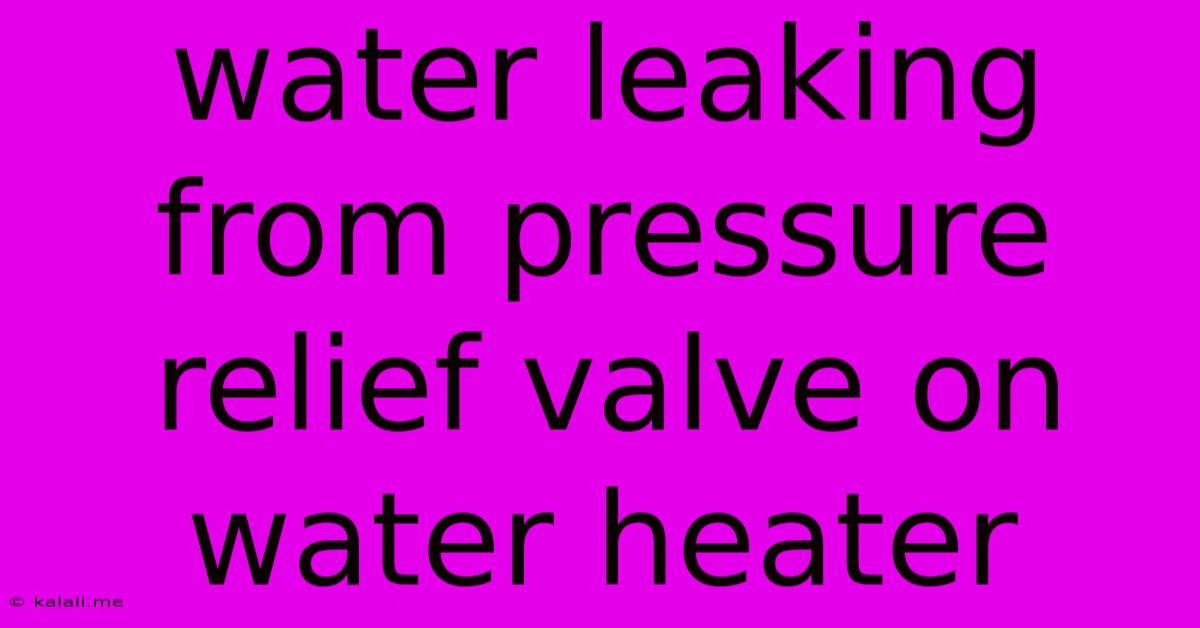Water Leaking From Pressure Relief Valve On Water Heater
Kalali
May 26, 2025 · 4 min read

Table of Contents
Water Leaking From Pressure Relief Valve on Water Heater: Causes and Solutions
Meta Description: Discovering water leaking from your water heater's pressure relief valve? This comprehensive guide explains common causes, troubleshooting steps, and solutions to prevent further damage and ensure water heater safety.
A leaking pressure relief valve on your water heater is a serious issue that demands immediate attention. Ignoring it can lead to significant water damage, costly repairs, and even potential safety hazards. This guide will walk you through understanding why your water heater is leaking from the pressure relief valve, how to troubleshoot the problem, and what steps you can take to fix it. We'll cover everything from identifying the problem to preventing future leaks.
Understanding the Pressure Relief Valve
Before diving into troubleshooting, let's understand the function of the pressure relief valve (PRV). This vital safety device is designed to release excess pressure and temperature build-up within your water heater tank. If the pressure inside exceeds a predetermined limit (typically around 150 PSI), the valve automatically opens, releasing hot water to prevent a potentially dangerous explosion. A slight drip is sometimes normal, but a steady stream indicates a problem.
Common Causes of a Leaking Pressure Relief Valve
Several factors can trigger a leak from your water heater's pressure relief valve:
- Excessive Water Pressure: This is the most common culprit. High water pressure in your home's plumbing system forces the valve to open, resulting in a continuous leak. Check your home's water pressure using a pressure gauge; ideally, it should be between 40 and 60 PSI.
- Temperature and Pressure Relief (T&P) Valve Malfunction: The valve itself might be faulty. Mineral buildup, corrosion, or simply wear and tear can prevent the valve from sealing properly, causing a leak even at normal pressure.
- Overheating Water Heater: A malfunctioning thermostat or heating element can cause the water to overheat, triggering the pressure relief valve to release excess pressure and steam. This is often accompanied by unusual noises from the water heater.
- Sediment Buildup: Over time, sediment accumulates at the bottom of the water heater tank. This sediment can restrict water flow and increase pressure, leading to valve activation.
- Expansion Tank Issues: If your home has an expansion tank designed to absorb pressure fluctuations, a malfunctioning or improperly sized tank can also lead to excessive pressure in the water heater.
Troubleshooting and Solutions
1. Check Your Home's Water Pressure: Use a water pressure gauge to measure the pressure at an outside tap. If it's excessively high (above 60 PSI), contact your local water utility company or a plumber to address the issue. They may be able to install a pressure regulator to reduce the incoming water pressure.
2. Inspect the Pressure Relief Valve: Carefully examine the valve for any visible damage, corrosion, or mineral buildup. A small drip is often acceptable, but a steady stream of water indicates a problem. If the valve is visibly damaged, replacement is necessary.
3. Test the T&P Valve (with caution): Gently lift the small lever on top of the valve. Water should flow briefly; if no water flows, the valve may be stuck or malfunctioning, requiring replacement. Always be extremely cautious when performing this test as hot water will be released.
4. Check for Overheating: Listen for unusual noises coming from the water heater. If you suspect overheating, consider checking the thermostat and heating element. Consult a professional if you lack the expertise to perform these checks safely.
5. Flush the Water Heater (if sediment is suspected): If sediment buildup is suspected, flushing the water heater may help. This is a more involved process and should be done carefully; consult online resources or a plumbing professional if you are unsure.
6. Assess the Expansion Tank (if applicable): If your home has an expansion tank, have it inspected by a plumber to ensure it's functioning correctly and appropriately sized for your system.
Preventing Future Leaks
Regular maintenance is key to preventing future leaks. This includes:
- Annual Inspection: Have a qualified plumber inspect your water heater annually.
- Regular Flushing: Flush your water heater every 6-12 months to remove sediment buildup.
- Monitoring Water Pressure: Regularly check your home's water pressure to ensure it remains within the recommended range.
A leaking pressure relief valve is a serious issue that shouldn't be ignored. By understanding the causes and taking the appropriate steps, you can prevent costly repairs and ensure the safety of your home. If you are unsure about any aspect of this process, always consult a qualified plumber.
Latest Posts
Latest Posts
-
Bledner Video Editing Images In Reverse
May 27, 2025
-
What To Do If You Ve Heard This Before
May 27, 2025
-
Standard Height For Closet Rod And Shelf
May 27, 2025
-
Does God Hear A Sinners Prayer
May 27, 2025
-
How To Check Coil For Spark
May 27, 2025
Related Post
Thank you for visiting our website which covers about Water Leaking From Pressure Relief Valve On Water Heater . We hope the information provided has been useful to you. Feel free to contact us if you have any questions or need further assistance. See you next time and don't miss to bookmark.